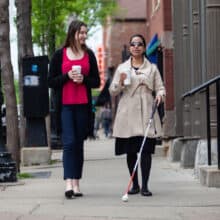
How Do Blind and Visually Impaired People Go Swimming?
After many discussions with my high school swimming teacher (and mustering up some courage), I finally decided to take swimming class during my senior year. It wasn’t that I thought I couldn’t swim because of my disability, but rather I had the same fear the average person has of sinking and drowning!! Being the only blind student in the class, I was unsure about how exactly I would keep up with my classmates. Luckily, my swimming teacher was very accommodating, and made sure my fears didn’t become a reality! She worked one-on-one with me and physically taught me how to do each movement before letting me practice on my own.
Like our sighted counterparts, blind and visually impaired individuals swim for pleasure, recreation and competition. There are many simple adaptations that allow us to enjoy this wonderful activity!
Some people wonder how those of us who are blind or have low vision manage to swim straight and stay in the lane. There are several methods we can use, and there is no one technique that works better than others.
Visually impaired swimmers can get tactile feedback from swim ropes, or lane markers. Beth Finke has been blind since she was 26 years-old. She swims several times a week for exercise, and finds lane markers very helpful. According to her memoir Long Time, No See, Beth took a swimming class after losing her sight in hopes of learning to swim straight.
To learn to do the crawl more evenly and end up going straight, my teacher gave me hands-on instruction. He stood behind me at the edge of the pool, grabbed my arms and pulled them up in the air. “Reach up as far as you can,” he instructed, “then pull back toward your belly button.”
“And concentrate!” he yelled at me once I got into the pool. I pushed off the side, concentrated, and banged right into a lane-marker. I tried again, pushed off the side, and careened from one lane-marker to the other all the way down the lane and back. I was an underwater pinball. I needed that lane all to myself.
I never did learn to swim straight. I asked my teacher if it’d be all right if I tapped each lane marker with my hand just to keep my bearings. “It’ll slow down your stroke,” he warned, as though I actually cared about being speedy or competitive. But I let him keep coaching me to improve my stroke.
As a blind swimmer, I also find lane markers helpful, especially when I’m swimming by myself. Brightly colored lane markers can be of great help to swimmers with low vision as well.
Swimmers with little or no vision and who participate in sports or competition might prefer to use “tappers.” Simply put, this is a specially trained person who warns the swimmer of when he or she is near the end of the pool or needs to make a turn. They do this by “tapping” the swimmer with a long foam poll.
Other simple techniques can make swimming enjoyable. Counting the strokes from one end of the pool to the other helps swimmers slow down when they are approaching the end of the lane. Placing a beeping device, radio or brightly colored beach towel can also let swimmers know when they are near the end of the pool.
No matter what techniques you use, the important thing is to have fun swimming! How did Beth do in her swimming class? Again from her memoir:
I got an “A” in the class. I swim three times a week now, tapping the lane marker with my right hand on every other stroke.
Like Beth, I also got an “A”! Swimming is one of my favorite recreational activities, especially during the summer!
You can find more tips and resources on swimming as a person with a visual impairment here. I also invite you to check out my friend Beth’s blog and read more about her many adventures.
What other suggestions do you have for swimming as a person with vision loss? Please comment! You can also send questions related to blindness or visual impairment to sandysview@chicagolighthouse.org. Thanks for reading, and stay cool!





